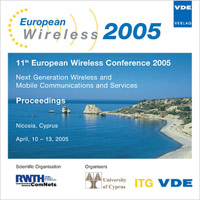Comparison between Multi-Code Transmission and Multi-Level Modulation in the DS-CDMA Uplink
Conference: European Wireless 2005 - 11th European Wireless Conference 2005 - Next Generation wireless and Mobile Communications and Services
04/10/2006 - 04/13/2005 at Nicosia, Cyprus
Proceedings: European Wireless 2005
Pages: 7Language: englishTyp: PDF
Personal VDE Members are entitled to a 10% discount on this title
Authors:
Prätor, Oliver; Lonnstrom, Andrew; Fettweis, Gerhard P. (Dresden University of Technology, Vodafone Chair Mobile Communications Systems, 01062 Dresden, Germany)
Abstract:
The system spectral efficiency is considered for the single-cell DS-CDMA uplink with random spreading and flat Rayleigh fading channels. Based on the asymptotic analysis for large systems, the signal-to-interference-and-noise ratio after the linear minimum mean-squarederror detector is determined analytically for multi-code transmission. This measure is used to obtain the maximum rate and thus efficiency by applying the concepts of coding at capacity and at cut-off rate. The efficiency of multiple codes is compared to multi-level modulation for different signal-to-noise ratios and system loads. It is shown that multi-code transmission improves efficiency for lower loads, but cannot increase its maximum value. In contrast, with multi-level modulation the maximum efficiency can be increased in the low-noise region. The accuracy of these results is investigated by means of simulations. Both simulation and asymptotic theoretical results are very close. Finally, the optimal parameters are compared to the UMTS parameter set. The study suggests increasing both spreading factor and modulation order to achieve better spectral efficiency when using an linear minimum mean-squared-error detector.


